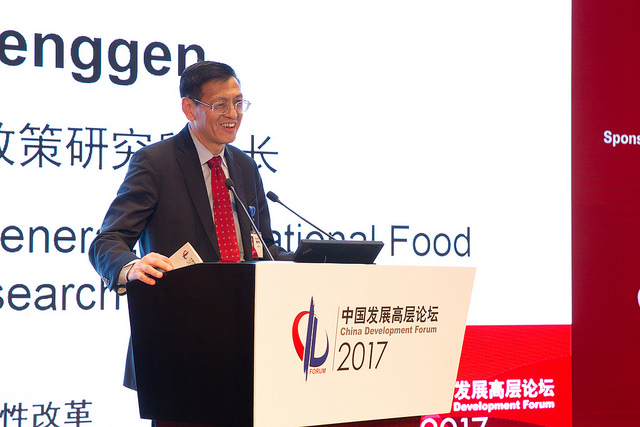Changing dietary patterns associated with rapid urbanization and growing population present new challenges to China’s agricultural sector. While China has a fast-growing economy and has made great strides to reduce poverty in recent decades, more than 9 percent of its population remains undernourished.
The country’s current production structure is not meeting diverse consumption demands. For example, China has persistent grain surpluses while failing to meet the growing demand for high-value foods. Overall food production remains unbalanced, with shortages and surpluses occurring at the same time in different places. How should the Chinese government’s recently-launched series of economic reforms address such problems?
This was the topic discussed at a session titled “The Supply-Side Structural Reform in Agriculture”, chaired by IFPRI Director General Shenggen Fan, at the China Development Forum in Beijing in March. In 2016, China embarked on what it calls a “supply-side reform” effort aimed at revitalizing its sluggish economy. Proposed changes in agriculture include establishing a market-oriented pricing system targeted at eliminating oversupply of some grains.
But reform efforts can go further, Fan said. Agriculture should play a greater role in climate change adaptation, he said, by producing nutritious and safe food and providing jobs to millions. He proposed several areas where policy makers should focus efforts to accelerate agricultural supply-side reform:
- Encourage innovations among smallholder farmers to increase the food supply.
- Invest in agricultural R&D and technology innovations to produce more with less.
- Enable institutional innovation, particularly on rural cooperative-enterprise linkages.
- Set up systematic, market-oriented pricing systems to increase efficiency and farmers’ income.
- Enhance food processing technologies for better nutrition and health outcomes.
- Advance and guide supply-side reforms through open trade policies and structural transformation.
Innovation is key to supply-side structural reform, Fan said. A transparent and inclusive food system paired with coordinated policies and effective markets can eventually end hunger and malnutrition.
Han Jun, Vice Minister of China’s Office of the Central Leading Group on Financial and Economic Affairs and Vice Minister, China’s Office of Central Rural Work Leading Group, said that the Chinese government is pushing for policy changes on sustainable agriculture development. The goal is to reduce direct market intervention while protecting the farmers’ interests. To achieve the Sustainable Development Goals (SDGs), Han said, it is essential to promote green production and reduce the overuse of fertilizers.
Qu Dongyu, Vice Minister of China’s Ministry of Agriculture, explained that supply and demand imbalance is a major challenge to supply-side structural reform. In addition, he said, farmers’ income has failed to increase steadily due in part to natural resource scarcity. Reform, he said, should be standardized, internationalized, branded, and market- and information- oriented.
Technological innovation is critical for both small and large-scale farms, said Monsanto CEO Hugh Grant: Only through innovation, can farmers increase yields while protecting the environment and produce better, more nutritious foods.
According to Patrick Yu, president of COFCO Corporation, the key challenge of China’s supply-side structural reform in agriculture lies in addressing structural imbalance, market competitiveness, and food safety.
Soren Schroder, CEO of Bunge Limited, said that China should accelerate its reforms on the pricing mechanisms for agricultural products and land. China should further open its agricultural industry to foreign investments, he suggested, and rely more on global trade and markets.
In an interview with Sina.com prior to the meeting, Fan explained that a reshaped and inclusive food system will give low-income populations better access to healthy and nutritious foods; this is why a supply-side reform in agriculture is both timely and pressing.
The China Development Forum, organized by the China Development Research Center of the State Council, is the preeminent platform for dialogue between China’s senior leadership and representatives of leading global businesses, international organizations, and scholars. The theme of this year’s forum was “China and the World: Economic Transformation through Structural Reforms.”
Meizhu Hong is an IFPRI Communucations Assistant, based in Beijing. Xinyuan Shang is an IFPRI Communications Specialist.







